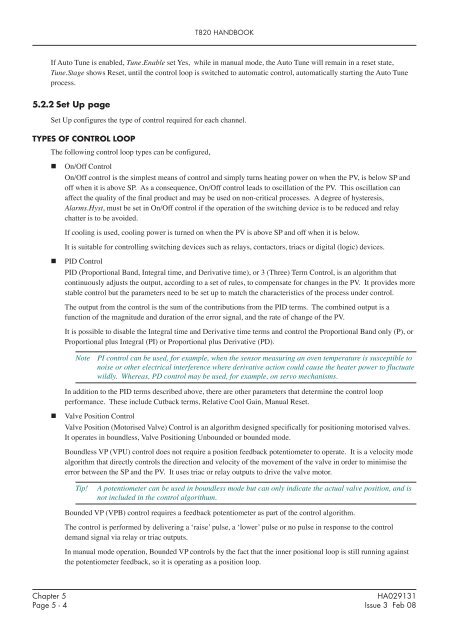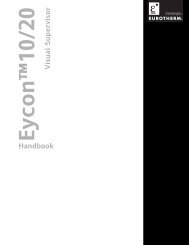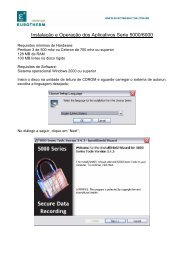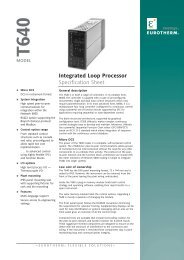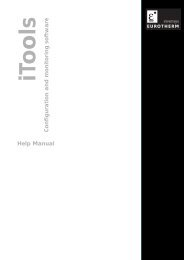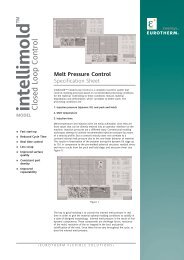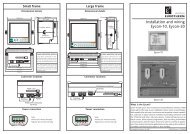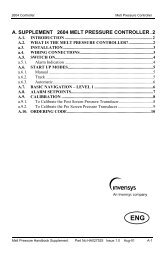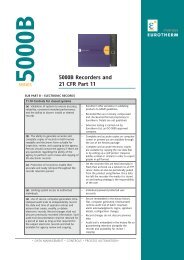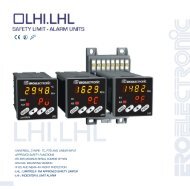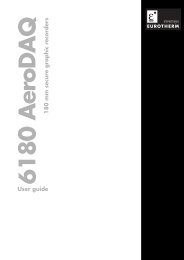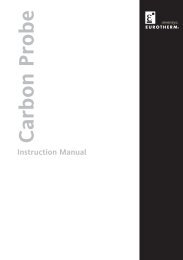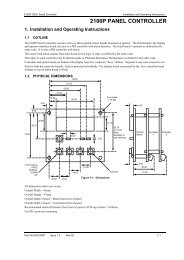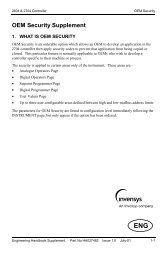Handbook - Eurotherm Ltda
Handbook - Eurotherm Ltda
Handbook - Eurotherm Ltda
You also want an ePaper? Increase the reach of your titles
YUMPU automatically turns print PDFs into web optimized ePapers that Google loves.
T820 HANDBOOKIf Auto Tune is enabled, Tune.Enable set Yes, while in manual mode, the Auto Tune will remain in a reset state,Tune.Stage shows Reset, until the control loop is switched to automatic control, automatically starting the Auto Tuneprocess.5.2.2 Set Up pageSet Up configures the type of control required for each channel.TYPES OF CONTROL LOOPThe following control loop types can be configured,• On/Off ControlOn/Off control is the simplest means of control and simply turns heating power on when the PV, is below SP andoff when it is above SP. As a consequence, On/Off control leads to oscillation of the PV. This oscillation canaffect the quality of the final product and may be used on non-critical processes. A degree of hysteresis,Alarms.Hyst, must be set in On/Off control if the operation of the switching device is to be reduced and relaychatter is to be avoided.If cooling is used, cooling power is turned on when the PV is above SP and off when it is below.It is suitable for controlling switching devices such as relays, contactors, triacs or digital (logic) devices.• PID ControlPID (Proportional Band, Integral time, and Derivative time), or 3 (Three) Term Control, is an algorithm thatcontinuously adjusts the output, according to a set of rules, to compensate for changes in the PV. It provides morestable control but the parameters need to be set up to match the characteristics of the process under control.The output from the control is the sum of the contributions from the PID terms. The combined output is afunction of the magnitude and duration of the error signal, and the rate of change of the PV.It is possible to disable the Integral time and Derivative time terms and control the Proportional Band only (P), orProportional plus Integral (PI) or Proportional plus Derivative (PD).NotePI control can be used, for example, when the sensor measuring an oven temperature is susceptible tonoise or other electrical interference where derivative action could cause the heater power to fluctuatewildly. Whereas, PD control may be used, for example, on servo mechanisms.In addition to the PID terms described above, there are other parameters that determine the control loopperformance. These include Cutback terms, Relative Cool Gain, Manual Reset.• Valve Position ControlValve Position (Motorised Valve) Control is an algorithm designed specifically for positioning motorised valves.It operates in boundless, Valve Positioning Unbounded or bounded mode.Boundless VP (VPU) control does not require a position feedback potentiometer to operate. It is a velocity modealgorithm that directly controls the direction and velocity of the movement of the valve in order to minimise theerror between the SP and the PV. It uses triac or relay outputs to drive the valve motor.Tip!A potentiometer can be used in boundless mode but can only indicate the actual valve position, and isnot included in the control algorithum.Bounded VP (VPB) control requires a feedback potentiometer as part of the control algorithm.The control is performed by delivering a ‘raise’ pulse, a ‘lower’ pulse or no pulse in response to the controldemand signal via relay or triac outputs.In manual mode operation, Bounded VP controls by the fact that the inner positional loop is still running againstthe potentiometer feedback, so it is operating as a position loop.Chapter 5Page 5 - 4HA029131Issue 3 Feb 08


